What you need is initiating your mass array with one additional element. I mean
...
m = [mi]*N # mass array [!!!] instead of (N-1) [!!!]
...
Idem for your springs
...
k = [ki]*N
...
Consequently, you can keep k[0] equal to 10. since you model reflective ends. You may thus want to comment or drop this line
...
##k[0] = 0
...
For aesthetic considerations you may want to fill the gap at the end of the x-axis. In this case, simply do
N = 201 # Number of mass points
Your code thus becomes
from numpy import *
from matplotlib.pyplot import *
# Variables
N = 201 # Number of mass points
nT = 1200 # Number of time points
mi = 0.02 # mass in kg
m = [mi]*N # mass array
m[-1] = 100 # Large last mass reflective edges
m[0] = 100 # Large first mass reflective edges
ki = 10.#spring
k = [ki]*N
k[-1] = 0
dx = 0.2
kappa = ki*dx
my = mi/dx
c = sqrt(kappa/my) # velocity
dt = 0.04
# 3 vectors
x = arange( N )*dx # x points
t = arange( N )*dt # t points
y = zeros( [N, nT ] )# 2D array
# Loop over initial condition
for i in range(N-1):
y[i,0] = sin((7.*pi*i)/(N-1)) # Initial condition dependent on mass point
# Iterating over time and position to find next position of wave
for j in range(nT-1):
for i in range(N-1):
y[i,j+1] = 2*y[i,j] - y[i,j-1] + (dt**2/m[i])*(k[i-1]*y[i+1,j] -2*k[i-1]*y[i,j] + k[i]*y[i-1,j] )
#check values of edges
print y[:2,j+1],y[-2:,j+1]
# Creates an animation
cla()
ylabel("Amplitude")
xlabel("x")
ylim(-10,10)
plot(x,y[:,j-2])
pause(0.001)
close()
which produces

Following your comment, I think that if you want to see the wave traveling along the string before reflection, you should not initiate conditions everywhere (in space). I mean, e.g., doing
...
# Loop over initial condition
for i in range(N-1):
ci_i = sin(7.*pi*i/(N-1)) # Initial condition dependent on mass point
if np.sign(ci_i*y[i-1,0])<0:
break
else:
y[i,0] = ci_i
...
produces

New attempt after answers:
from numpy import *
from matplotlib.pyplot import *
N = 201
nT = 1200
mi = 0.02
m = [mi]*(N)
m[-1] = 1000
m[0] = 1000
ki = 10.
k = [ki]*N
dx = 0.2
kappa = ki*dx
my = mi/dx
c = sqrt(kappa/my)
dt = 0.04
x = arange( N )*dx
t = arange( N )*dt
y = zeros( [N, nT ] )
for i in range(N-1):
y[i,0] = sin((7.*pi*i)/(N-1))
for j in range(nT-1):
for i in range(N-1):
if j == 0: # if j = 0 then ... y[i,j-1]=y[i,j]
y[i,j+1] = 2*y[i,j] - y[i,j] + (dt**2/m[i])*(k[i-1]*y[i+1,j] -2*k[i-1]*y[i,j] + k[i]*y[i-1,j] )
else:
y[i,j+1] = 2*y[i,j] - y[i,j-1] + (dt**2/m[i])*( k[i-1]*y[i+1,j] -2*k[i-1]*y[i,j] + k[i]*y[i-1,j] )
cla()
ylim(-1,1)
plot(x,y[:,j-2])
pause(0.0001)
ylabel("Amplitude")
xlabel("x")
print len(x), len(t), N,nT
Here is a plot of the new attempt at solution with |amplitude| of anti node equal 1.0. Will this do anything with further solving the issue with indices?



